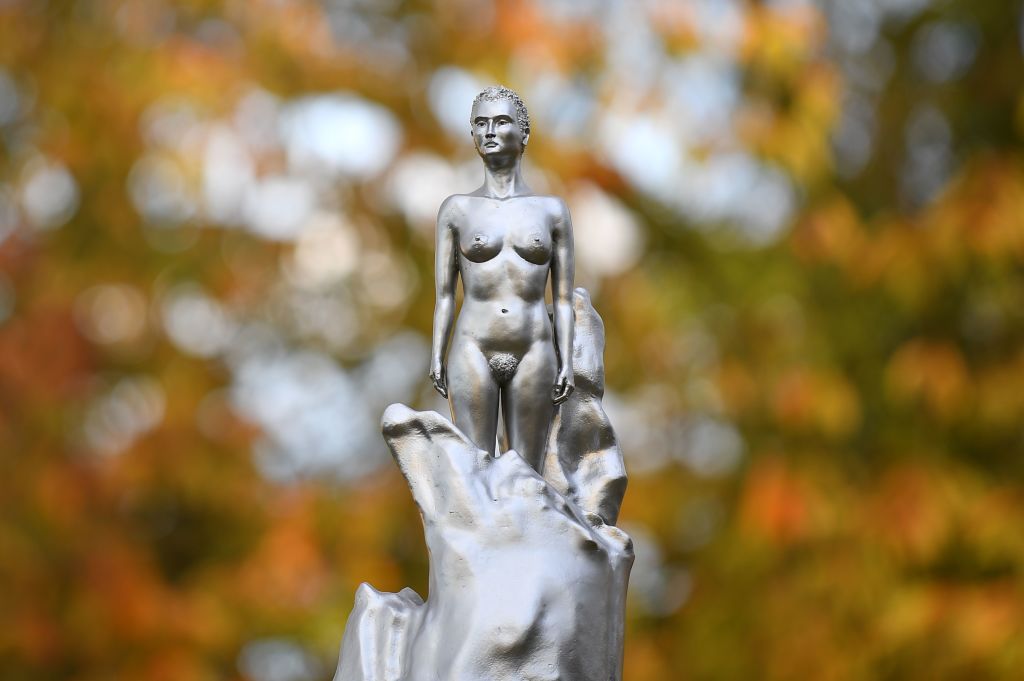It has not been a good year for statues. The latest creative controversy now surrounds the newly unveiled Mary Wollstonecraft memorial in Newington Green, Islington. Sadly, this monument to the ‘mother of feminism’ is more pubic art than public art: a tiny, naked female, all shredded abs and bouffant bush, on top of a strange swirl of organic matter.
Apparently, the statue is not Wollstonecraft herself, but a tribute to her spirit. This is rather ironic, given that Wollstonecraft dedicated a whole chapter to Vindication of the Rights of Woman to how women’s minds should be admired over their bodies.
It is wrong on so many levels. Aesthetically, it is awful; it has been compared to a ‘Rolls-Royce hood ornament’, a ‘silvered mantelpiece trinket’ and a ‘whirl of metal with the visual charisma of a doorknob.’ Politically, it misses the mark; it’s hardly radical (the world doesn’t exactly need more female nudes), nor is it representative of anything Wollstonecraft – writer, philosopher, campaigner, and mother to Mary Shelley – stood for.
Looking at the proposals by the finalists, this is a clear case of identity politics and political correctness gone wrong. The fact that the committee chose Maggi Hambling’s design over the alternative is so mind-boggling, so completely incomprehensible, that it raises an important question: did they choose her design because she was a woman, and the other finalist was a man?
The alternative design, proposed by Martin Jennings, had Wollstonecraft fully clothed (bonnet and all), clutching a quill and standing over a toppling stack of books. Not the most original idea in the world, but one that, as Jennings himself said, is testament to her ‘heroic courage’ in campaigning for women’s rights despite the ‘considerable risk to her reputation.’ Instead, we are given tiny silver-boobed Barbie.
The irony is as thick as the strange genie cloud the figure stands on. A female sculptor has created something so obviously anti-feminist and out of tune with the times. Only one in ten statues in London are of a woman, and what a wasted opportunity to create something memorable and meaningful. The statue is both disrespectful and regressive: you don’t see many statues of Shakespeare’s codpiece or J. S. Mill naked. Give me a statue of Descartes’ perky derrière, and then we’ll talk.
To make matters worse, Hambling tried to defend her decision to have a nude woman by saying that ‘we all know clothes are limiting, and she is everywoman. As far as I know, she’s more or less the shape we’d all like to be.’ Would anyone (except perhaps an Instagram fitness influencer) see themselves reflected in this toned totem pole? But it’s good to know that whilst this ‘everywoman’ is not illustrative of Wollstonecraft’s contribution to society, she is at least beach body ready.
The backlash should hardly have come as a shock; Hambling’s work is notoriously contentious and divisive. In 1998 she managed to turn Oscar Wilde into a hideous Medusa figure with macaroni hair trapped in a sarcophagus.
This statue is what happens when we prioritise artistic edginess over the actual meaning or impact of the work for the average person. Of course art is subjective, but the purpose of statues is not – they should be about celebration and recognition, and therefore it should be clear who and what we are recognising.
Hambling’s statue is a tenuous metaphor at best. For all its shaky claims to timelessness and symbolic fortitude, most people will see it for what it ultimately is: another nameless, nude, conventionally attractive female figure. Such an abstract representation might – just – be acceptable if Wollstonecraft was already an incredibly well known figure, but she isn’t, and this is hardly educational. Imagine showing students a nude figure of John Locke and telling them to focus on his Enlightenment philosophies rather than his enshrined phallus.
It is a muddled notion of equality that means that we seemingly choose the gender of an artist over the merit of a work of art. The committee must have thought they played it safe by choosing a woman, regardless of the end product. They probably thought that asking a man to produce a statue of a feminist icon would have raised questions (rightly or wrongly), and so went with the nude over the natural choice. How wrong they were.






Comments